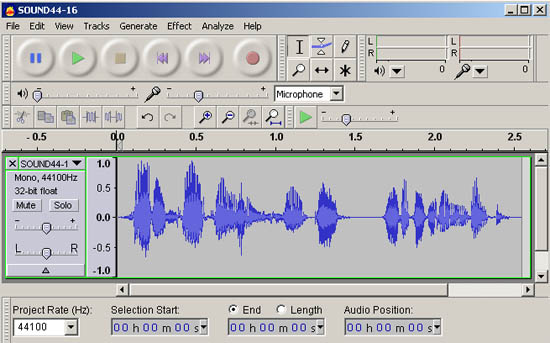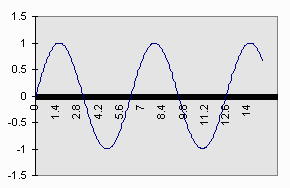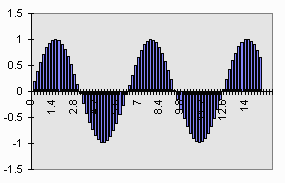Sound is made when objects vibrate producing pressure waves that can be picked up by our ears. These waves can be captured when they vibrate the membrane of a microphone and can be re-created by the amplified vibrations of the membrane in a speaker. If we graph the intensity of this wave or of the motion of the microphone membrane over time, we will get a smooth waveform curve in which the
frequency of a sound is the number of peaks per second (
Hertz = cycles per second). The distance between two peaks is the
wavelength. As with most physical properties (e.g. temperature, pressure, velocity, the shape of the groove of an LP), this is an
analog signal. In other words, between any two moments in time we might make infinite number of different measurements of
intensity, between any two points on the scale there can be an infinite number of different
values. Although the graph shown below is very simple,
waveforms (a graph of intensity) can be quite complex because many different frequencies are usually present simultaneously (a
spectral graph will show the distribution of frequencies in a sound).
When we store the signal in a computer, we need to represent the
analog signal by a
digital approximation that we can think of as a series of numbers measuring samples of the height of the analog curve. Computers by their nature can only have space for a limited number of measurements (not infinite) and each value can have a
precision limited by the space (number of
bytes) allotted to each number (Consider the difference in measuring something on a scale of 1 to 10 vs. a scale of 1 to 1000000). In this way, a series of numbers can be used to produce a signal that approximates the original analog signal, but it can never but truly the same. The more numbers you have (
sampling rate in kHz) and the more precise those number are (
resolution of each sample in
bits), the more the digital sound will resemble the original, but the larger your sound files will be. A digital waveform can never be completely smooth.
The advantages of digital recordings are that the sound can be manipulated computationally, there is no degradation from an original to a copy, and the signal can be sent for long distances over telecommunications links without picking up noise. The disadvantage of digital representation is that it is always just an approximation of the real sound (though the approximation may be so close that our ears can't hear the difference).
 Sound editing will be covered in a later lesson.
There are also other low cost programs available for sound editing that will do a fine job for most of your needs.
Sound editing will be covered in a later lesson.
There are also other low cost programs available for sound editing that will do a fine job for most of your needs. 
